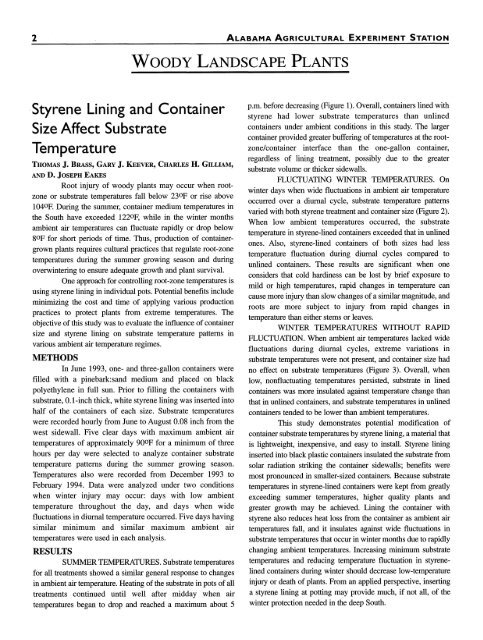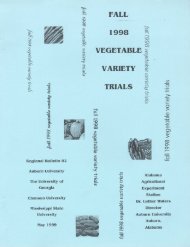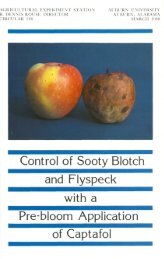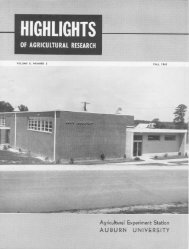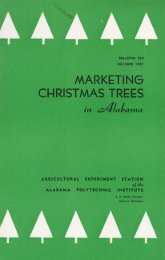1997 Ornamentals Research Report - AUrora - Auburn University
1997 Ornamentals Research Report - AUrora - Auburn University
1997 Ornamentals Research Report - AUrora - Auburn University
Create successful ePaper yourself
Turn your PDF publications into a flip-book with our unique Google optimized e-Paper software.
2<br />
Styrene Lining and Container<br />
Size Affect Substrate<br />
Temperature<br />
ALABAMA AGRICULTURAL EXPERIMENT STATION<br />
ALABAMA AGRICULTURAL EXPERIMENT STATION<br />
WOODY LANDSCAPE PLANTS<br />
THOMAS J. BRASS, GARY J. KEEVER, CHARLES H. GILLIAM,<br />
AND D. JOSEPH EAKES<br />
Root injury of woody plants may occur when rootzone<br />
or substrate temperatures fall below 230F or rise above<br />
1040F. During the summer, container medium temperatures in<br />
the South have exceeded 1220F, while in the winter months<br />
ambient air temperatures can fluctuate rapidly or drop below<br />
80F for short periods of time. Thus, production of containergrown<br />
plants requires cultural practices that regulate root-zone<br />
temperatures during the summer growing season and during<br />
overwintering to ensure adequate growth and plant survival.<br />
One approach for controlling root-zone temperatures is<br />
using styrene lining in individual pots. Potential benefits include<br />
minimizing the cost and time of applying various production<br />
practices to protect plants from extreme temperatures. The<br />
objective of this study was to evaluate the influence of container<br />
size and styrene lining on substrate temperature patterns in<br />
various ambient air temperature regimes.<br />
METHODS<br />
In June 1993, one- and three-gallon containers were<br />
filled with a pinebark:sand medium and placed on black<br />
polyethylene in full sun. Prior to filling the containers with<br />
substrate, 0.1-inch thick, white styrene lining was inserted into<br />
half of the containers of each size. Substrate temperatures<br />
were recorded hourly from June to August 0.08 inch from the<br />
west sidewall. Five clear days with maximum ambient air<br />
temperatures of approximately 90OF for a minimum of three<br />
hours per day were selected to analyze container substrate<br />
temperature patterns during the summer growing season.<br />
Temperatures also were recorded from December 1993 to<br />
February 1994. Data were analyzed under two conditions<br />
when winter injury may occur: days with low ambient<br />
temperature throughout the day, and days when wide<br />
fluctuations in diurnal temperature occurred. Five days having<br />
similar minimum and similar maximum ambient air<br />
temperatures were used in each analysis.<br />
RESULTS<br />
SUMMER TEMPERATURES. Substrate temperatures<br />
for al treatments showed a similar general response to changes<br />
in ambient air temperature. Heating of the substrate in pots of all<br />
treatments continued until well after midday when air<br />
temperatures began to drop and reached a maximum about 5<br />
p.m. before decreasing (Figure 1). Overall, containers lined with<br />
styrene had lower substrate temperatures than unlined<br />
containers under ambient conditions in this study. The larger<br />
container provided greater buffering of temperatures at the rootzone/container<br />
interface than the one-gallon container,<br />
regardless of lining treatment, possibly due to the greater<br />
substrate volume or thicker sidewalls.<br />
FLUCTUATNG WINTER TEMPERATURES. On<br />
winter days when wide fluctuations in ambient air temperature<br />
occurred over a diurnal cycle, substrate temperature patterns<br />
varied with both styrene treatment and container size (Figure 2).<br />
When low ambient temperatures occurred, the substrate<br />
temperature in styrene-lined containers exceeded that in unlined<br />
ones. Also, styrene-lined containers of both sizes had less<br />
temperature fluctuation during diurnal cycles compared to<br />
unlined containers. These results are significant when one<br />
considers that cold hardiness can be lost by brief exposure to<br />
mild or high temperatures, rapid changes in temperature can<br />
cause more injury than slow changes of a similar magnitude, and<br />
roots are more subject to injury from rapid changes in<br />
temperature than either stems or leaves.<br />
WINTER TEMPERATURES WITHOUT RAPID<br />
FLUCTUATION. When ambient air temperatures lacked wide<br />
fluctuations during diurnal cycles, extreme variations in<br />
substrate temperatures were not present, and container size had<br />
no effect on substrate temperatures (Figure 3). Overall, when<br />
low, nonfluctuating temperatures persisted, substrate in lined<br />
containers was more insulated against temperature change than<br />
that in unlined containers, and substrate temperatures in unlined<br />
containers tended to be lower than ambient temperatures.<br />
This study demonstrates potential modification of<br />
container substrate temperatures by styrene lining, a material that<br />
is lightweight, inexpensive, and easy to install. Styrene lining<br />
inserted into black plastic containers insulated the substrate from<br />
solar radiation striking the container sidewalls; benefits were<br />
most pronounced in smaller-sized containers. Because substrate<br />
temperatures in styrene-lined containers were kept from greatly<br />
exceeding summer temperatures, higher quality plants and<br />
greater growth may be achieved. Lining the container with<br />
styrene also reduces heat loss from the container as ambient air<br />
temperatures fall, and it insulates against wide fluctuations in<br />
substrate temperatures that occur in winter months due to rapidly<br />
changing ambient temperatures. Increasing minimum substrate<br />
temperatures and reducing temperature fluctuation in styrenelined<br />
containers during winter should decrease low-temperature<br />
injury or death of plants. From an applied perspective, inserting<br />
a styrene lining at potting may provide much, if not ail, of the<br />
winter protection needed in the deep South.


